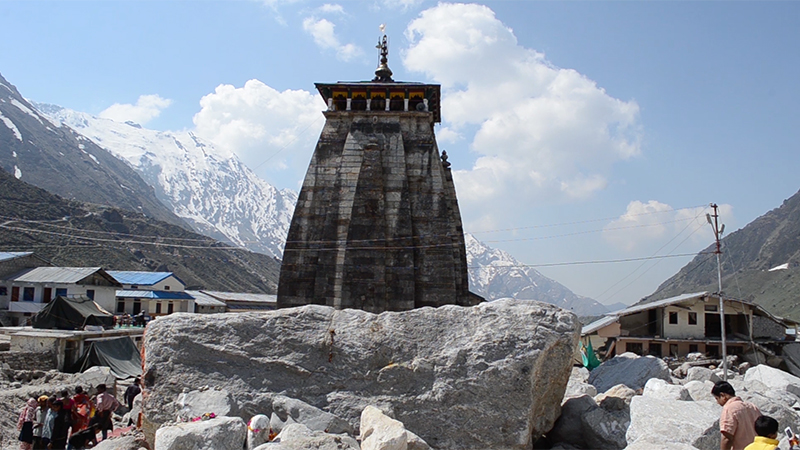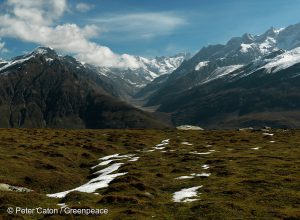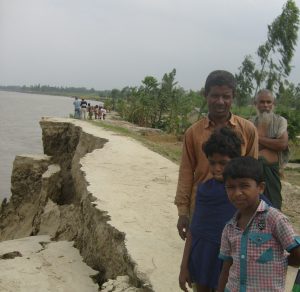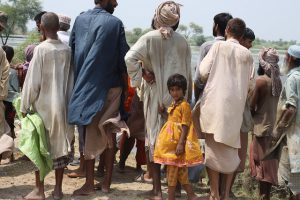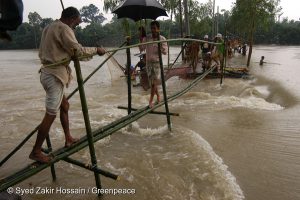Two years ago this month, a flood devastated the Himalayan village of Kedarnath, India, the destination of half a million Hindu pilgrims annually. The town sits 11,500 feet up in a tight valley. Sharp, snowy peaks tower on three sides and a stone temple sits at one end. The flood — which occurred on June 17, 2013 — was India’s worst disaster in a decade. Several thousand people drowned. The deluge tore apart dozens of bridges, swept away miles of paved roads, and carried off herds of livestock.
Government officials, scientific researchers, and media commentators soon speculated about the cause of the flood and about why so many people had died. They pointed to the early and heavy monsoon rains. They railed against poorly built homes, unregulated development along the Mandakini River that runs through Kedarnath, and soil erosion caused by thousands of pilgrims trekking on foot and on donkeys to reach this remote town in the northern Indian state of Uttarakhand.All these factors contributed. Yet in the two years since the flood, scientists studying with the care and intensity of forensic investigators have added another key cause: global warming. In recent papers, they conclude that melting glaciers and shifting storm tracks may soon set off more catastrophic floods in mountainous regions of India and adjacent countries. Atmospheric scientists say that in northern India the intense rains that preceded the disaster are extremely rare. But they have discovered that an unusual collision of weather systems steered storms over Uttarakhand and locked them in place, pouring rain down for days. Long-term changes in weather patterns are making such collisions more likely, a development that some scientists believe is caused by global warming. Global warming has is also melting glaciers all over the Himalayas, including one perched above Kedarnath. Some researchers say that had the glacier remained healthy, heavy rain alone would not have destabilized a gravel bank that collapsed, releasing a destructive pulse of debris-filled water.
Sitting on the carpet in his father’s living room, in New Delhi, 200 miles southwest of Kedarnath, Vaibhav Kaul, a young geographer, watched reports of the disaster on TV. He remembers thinking to himself, “that was exactly the kind of scenario I’d been studying for the year.” He’d recently completed a Masters degree in Environmental Change and Management at Oxford University in the United Kingdom. His thesis studied how Himalayan communities could better prepare for catastrophic floods from the lakes above them. He’d briefly considered making Kedarnath the subject of his research.
A devout Hindu and descended from Kashmiri Pandits — an elite caste that has produced many of India’s ruling class of scholars, administrators and politicians — Kaul had made the religious excursion to Kedarnath once before and hiked two hours above the town to Lake Chorabari Tal. But when he later read a report cataloging the Himalayan lakes most likely to flood and endanger communities below, Chorabari Tal was not among those listed as “potentially dangerous.” He decided to study towns elsewhere in the Himalayas instead. But his instincts proved to be correct.Four months after the flood, Kaul set off on a scientific pilgrimage to the disaster site, determined to learn why a town considered relatively safe had flooded. He wore a traditional robe, hanging to below his knees, and the sort of dark wool vest favored by men in Kashmir, the mountainous region of his ancestors.
The flood had severed the eight-mile footpath to Kedarnath from the rest of India. Kaul took a bus to Guptkashi, the closest town with public transport, but nearly 25 miles short of Kedarnath. He continued on foot, astonished at the scale of destruction even so far downstream. The flood had passed through Kedarnath and surged down the Mandakini, joined by swollen tributaries, gathering force and debris. Kaul saw bare abutments where bridges had stood and foundationless houses dangling above landslide scars. Thirty hydroelectric plants had been damaged or destroyed.
About four miles shy of Kedarnath, he came to the former site of Rambara, a way station that once had about 100 seasonal shopping stalls and several small hotels. Pilgrims had rested there over sweet, milky tea and fried flatbreads and bought camping supplies and religious trinkets. Kaul saw only an empty shelf of bedrock strewn with boulders. “One couldn’t imagine there’d been anything there,” he said later.Some of of Kedarnath’s steel-reinforced concrete guesthouses and stuccoed fieldstone homes survived better. Still, nearly three quarters of its 259 buildings had been damaged. More than half had been battered and washed away. The flood took most of its victims in Kedarnath, the season’s first pilgrims. “They were still finding dead people,” Kaul recalled, noting that he had smelled rotting flesh and watched relief workers excavate a severed leg.
Kaul climbed steep hills to an overlook about 2,000 feet above the town. The top of a hulking mountain, nearly 23,000 feet tall and crowned by Chorabari glacier, appeared. It blocked the sky at the head of the valley. At an inflection point, where the slope leveled off, a vast tongue of ice stretched out for a mile. Kaul looked for Chorabari Tal. It should have been visible below him, near the tongue’s tip. But there was no lake to be seen.
Titanic geologic forces had forged Chorabari Tal during the widespread cold spell that lasted from about 1300 to 1870 and is known as the Little Ice Age. The glacier had bulldozed stone into linear piles — moraines — jammed between the advancing tongue and the valley’s bedrock rim. The ice had then receded, leaving the lake’s lens-shaped basin, a depression with no outlet. Rain and melted snow filled it every spring and summer. At times, water drained out through the porous moraine, and the water level dropped.
Now, as Kaul looked down, he saw that the basin was empty. He knew what had occurred: The moraine had ruptured, letting loose the lake’s entire contents in a catastrophic spasm.
From his overlook, Kaul saw the boulder that had saved the temple from destruction. Miraculously, the deluge had scooped up this 30-foot-long rock and dropped it, perpendicular to the current, just steps short of the temple, where it had deflected the churning waters around the historic building.Kaul snapped a set of pictures. A few weeks later, British geographer Dave Petley, at the University of East Anglia, published some of Kaul’s photos on a blog widely read by landslide researchers. These photos proved what Petley and other scientists had suspected from blurry satellite images released by India’s space agency. They showed a V-shaped cut in the natural dike that had dammed Chorabari Tal for centuries. An 18-wheeler could fit through the break in the gravel wall.
Terrified pilgrims and inhabitants had huddled inside any shelter they found. Survivors describe hearing a tremendous boom. The torrent poured into the Mandakini River, already raging above the town with the downpours and snowmelt. Chandi Prasad Tiwari, a shopkeeper, saw a wave crest over a three-story building. “God, please help us, please help us,” he recalls sobbing. He felt sure he’d die.The Chorabari Tal’s basin is not huge. “Just a puddle,” Kaul says. But it probably released its entire contents, about 100 million gallons, in a quarter of an hour, say scientists at the University of Calcutta. The team estimated that for several minutes the torrent pounded Kedarnath with half the flow of Niagara Falls.
In an interview at Jawaharlal Nehru University in New Delhi, A. P. Dimri, a specialist in Himalayan weather patterns, says that a freak collision of a Western Disturbance and the summer monsoon combined in the extreme rains of June, 2013 (see this paper he coauthored). The monsoon struck southeastern India as usual, in the second week of the month. But clouds raced north and west with extraordinary speed. The rain arrived in Uttrakhand two weeks ahead of schedule, crashing into that Western Disturbance. Dimri says the two opposing systems of moisture-laden air “smushed together,” into a Frankenstorm that stayed pinned for two days to the southern flank of the Himalayas. Some researchers say similar conditions may have loosed floods that killed 3,000 people in Pakistan and northern India in the summer of 2010.Several recent research papers say that global warming may have set up Kednarath for the disaster, by transforming regional weather patterns and eroding Chorabari Glacier. Western Disturbance storms are becoming more frequent and lasting longer. The monsoon is launching its march across India earlier and traveling faster. Dimri says that global warming may be responsible for this transformation of India’s weather.
